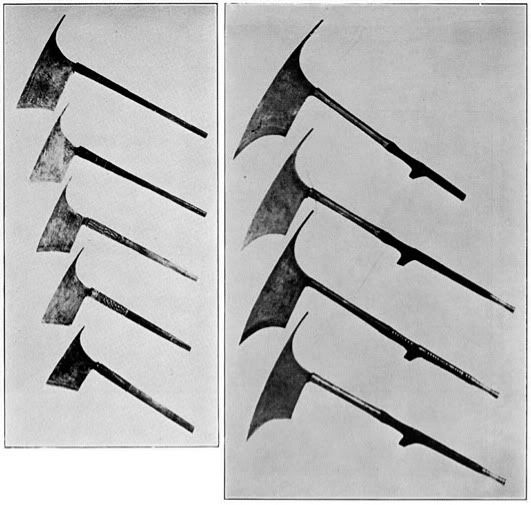
 |
|
|
#17 |
|
Member
Join Date: Oct 2008
Location: Manila, Phils.
Posts: 1,042
|
More, from The Bontoc Igorot --
 On the Bontoc battle-axe [left side in pic]: "Baliwang [Cordillera] has four smithies ... Baliwang alone makes the genuine Bontoc battle-ax. It is a strong, serviceable blade of good temper, and is hafted to a short, strong, straight wooden handle which is strengthened by a ferrule of iron or braided bejuco. The ax has a slender point opposed to the bit or cutting edge of the blade ... The bit of the ax is at a small angle with the front and back edges of the blade, and is nearly a straight line. The axes are kept keen and sharp by whetstones collected and preserved solely for the purpose. Besao, near Sagada, quarries and barters a good grade of whetstone."On the sleek Balbelasan battle-axe [right side in pic]: "A slender, long-handled battle-ax now and then comes into the area in trade from the north. Balbelasan, of old Abra Province, but now in the northern part of extended Bontoc Province, is one of the pueblos which produce this beautiful ax. The blade is longer and very much slimmer than the Bontoc blade, but its marked distinguishing feature is the shape of the cutting edge. The blade is ground on two straight lines joined together by a short curved line, giving the edge the striking form of the beak of a rapacious bird. The slender, graceful handle, always fitted with a long iron ferrule, has a process on the under side near the middle. The handle is also usually fitted with a decorated metal ferrule at the tip and frequently is decorated for its full length with bands of brass or tin, or with sheets of either metal artistically incised.On the variations in the use and non-use of the battle axe: "In the southern and western part of the Bontoc area the battle-ax shares place with the bolo, the sole hand weapon of the Igorot of adjoining Lepanto, Benguet, and Nueva Vizcaya Provinces.On the Sapao bolo and the Moro barong: "The Sapao bolo is, in appearance, superior to that of Ilokano manufacture. It is a broad blade swelling markedly toward the center, and is somewhat similar in shape to the barong of the Sulu Moro of the Sulu Archipelago. This weapon finds its chief field of use in the Quiangan and Banawi areas."One of the pics below shows a Sapao smithy. Note also in the pics below that it was the same "Malay forge" [also called the double-bellows forge, a 2,000-year old design?] that was used throughout the Philippines, whether it was in the highlands of the Cordillera in northern Luzon, or down south in the Moro areas of Mindanao. Finally, the color pic below is from the Ayala Museum dioramas. It depicts what a foundry in ancient Phils. must have looked like, i.e., about 1,500 to 2,000 years ago. |
|
|

|
|
|